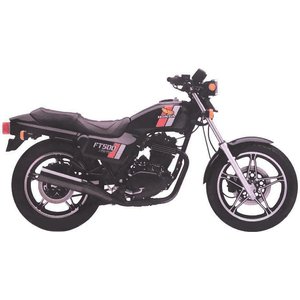Honda FT 500 [1982-1985]: A Timeless Single-Cylinder Companion Revisited
Introduction
The Honda FT 500, produced between 1982 and 1985, occupies a unique niche in motorcycling history. As Honda’s answer to the growing demand for simple, lightweight, and versatile street bikes, this air-cooled single-cylinder machine carved out a reputation for reliability and approachable performance. While modern riders might gravitate toward high-tech machinery, the FT 500 remains a compelling choice for those who value mechanical simplicity and a raw, unadulterated riding experience. Let’s take a fresh look at what makes this generation of the FT 500 a hidden gem for enthusiasts and daily riders alike.
Design & Styling: Classic Minimalism
The FT 500’s design is a masterclass in early-’80s pragmatism. Its no-frills aesthetic features a slender steel frame, a teardrop-shaped fuel tank, and a flat bench seat that prioritizes function over flair. The round headlight and analog instrumentation (speedometer, odometer, and basic warning lights) reinforce its minimalist ethos. Weighing in at 159 kg (350 lbs), the bike feels compact and unintimidating, with a seat height that accommodates riders of varying statures. The spoked wheels and slender profile give it a timeless, almost universal appeal—equally at home on city streets or country backroads.
Performance: The Thumper’s Heartbeat
Engine Character
At the core of the FT 500 lies a 498 cc (30.4 cubic inches) single-cylinder, air-cooled engine. With an output of 35 PS (26 kW) at its peak—or 27 PS (20 kW) in certain markets—this isn’t a bike built for outright speed. Instead, it thrives on low-end torque and tractability. The thumper’s vibration is noticeable but never harsh, settling into a rhythmic pulse once past 3,000 RPM.
Carburetion is handled by a single Keihin unit, tuned with a 2.5-turn air screw adjustment out of the factory. This setup delivers crisp throttle response in low-to-mid rev ranges, though riders might notice a flat spot near the top end. The 5-speed transmission shifts smoothly, with a light clutch pull that makes stop-and-go traffic manageable.
Fuel Efficiency & Range
With a 13.5-liter (3.57-gallon) fuel tank, the FT 500 offers a practical range of around 240 km (150 miles) before refueling. Its frugal appetite—roughly 4.2 L/100 km (56 mpg)—means fewer pit stops on long rides, though the upright riding position might limit highway comfort over extended distances.
Handling & Ride Experience: Lightweight Agility
Chassis Dynamics
The FT 500’s tubular steel frame and 37 mm telescopic forks (330 ml of SAE 10W oil per leg) provide a compliant yet communicative ride. At low speeds, the bike feels flickable and precise, aided by its 159 kg (350 lbs) curb weight. The rear dual shocks, adjustable for preload, handle moderate bumps competently, though sharp irregularities can jolt through the chassis.
Tire Pressures & Gearing
Honda recommended 1.75 bar (25 psi) upfront and 2.0 bar (29 psi) at the rear—a setup that balances grip and stability for its era. The 15/40 sprocket combination and 100-link chain prioritize acceleration over top speed, making the FT 500 feel lively in urban environments. Cruising at 100 km/h (62 mph) is feasible, but the engine’s buzzy character encourages a more relaxed pace.
Braking Performance
The single front disc and rear drum brake combo, while dated by modern standards, provides adequate stopping power for the bike’s weight. Upgrading to DOT 4 fluid (as specified) improves lever feel and consistency, especially during aggressive riding.
Competition: How Does the FT 500 Stack Up?
The early ’80s single-cylinder segment was fiercely contested. Here’s how the Honda FT 500 compared to its rivals:
-
Yamaha SR500
The SR500’s 499 cc engine shared similar displacement but delivered a slightly rawer, more visceral experience. However, its kickstart-only design and heavier clutch made it less user-friendly than the Honda’s electric-start-equipped FT 500. -
Suzuki SP500
Suzuki’s offering leaned toward off-road capability, with longer-travel suspension and knobbier tires. While more versatile on dirt, it sacrificed road manners and refinement compared to the Honda. -
Kawasaki KZ400
The KZ400’s parallel-twin engine was smoother at higher RPMs but lacked the FT 500’s low-end grunt. Kawasaki’s design also felt bulkier, with less intuitive handling in tight spaces.
Verdict: The FT 500 struck a balance between usability and character, appealing to riders who wanted a street-focused machine without the quirks of its competitors.
Maintenance: Keeping the Thumper Alive
Key Considerations
-
Valve Adjustments
The FT 500 requires regular valve clearance checks: 0.05 mm (0.002 in) for intake and 0.10 mm (0.004 in) for exhaust valves (cold). Neglecting this can lead to noisy operation and reduced performance. -
Oil Changes
Use SAE 10W-40 oil—2.0 liters (2.11 quarts) without a filter change or 2.5 liters (2.64 quarts) with one. Stick to API SE-grade or higher for optimal engine protection. -
Carburetor Tuning
The stock 2.5-turn air screw setting is a solid baseline, but altitude or aftermarket exhausts may require fine-tuning. Clean the carb jets annually to prevent clogging. -
Chain & Sprockets
The 100-link chain and 15/40 sprockets wear predictably. Inspect for stiff links and adjust tension every 500 km (310 miles). A well-lubed chain extends component life significantly. -
Spark Plugs
NGK DR8EA (standard) or DR8EIX (iridium) plugs work best. Check the 0.7 mm (0.028 in) electrode gap during replacements.
MOTOPARTS.store Recommendations
- Upgrade to an iridium spark plug (DR8EIX) for longer service intervals.
- Swap the original brake fluid for high-performance DOT 4 to enhance braking consistency.
- Consider a premium aftermarket chain to reduce maintenance frequency.
Conclusion: Why the FT 500 Endures
The Honda FT 500 isn’t about cutting-edge specs or blistering speed—it’s about connection. The thumping single-cylinder engine, the minimalist controls, and the lightweight chassis create a riding experience that feels authentic and engaging. For commuters, it’s a dependable workhorse. For enthusiasts, it’s a blank canvas for customization. And for everyone else, it’s a reminder of motorcycling’s purest joys.
Whether you’re restoring a barn find or optimizing a daily rider, MOTOPARTS.store has the components and expertise to keep your FT 500 running smoothly for decades to come. After all, classics aren’t born—they’re maintained.



















